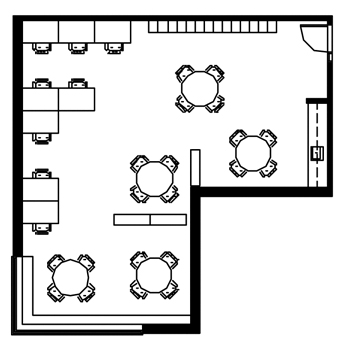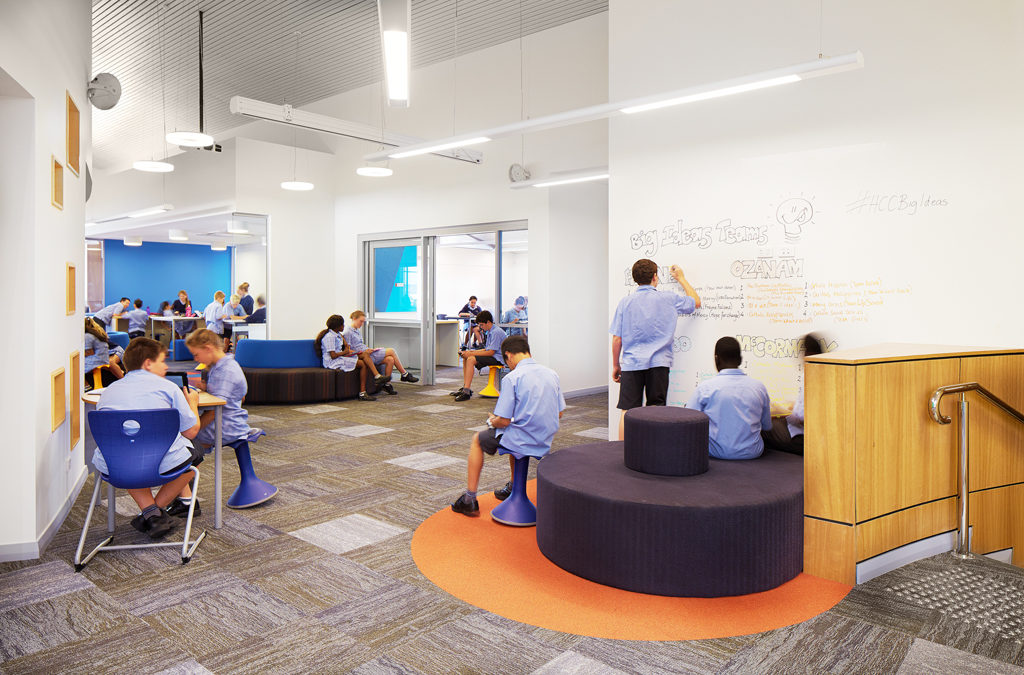In November of 1994, James A. Dyck published an article, “A Case for the L-Shape Classroom: Does the shape of a classroom affect the quality of the learning that goes inside it?” in Principle Magazine.
Unlike many articles and books that describe school settings, this article was grounded in research. With the understanding that schools are learning centers for development, and building on his research findings, Dyck proposed the layout of the ‘Fat L’ as a design pattern that offers teachers options in how they might organize their classrooms to facilitate the development of their students in various learning activities.
Since this article was written, there has been little analysis of how the ‘L’ Shape design pattern might influence learning as well as be incorporated into the design of new school facilities.

Figure 1: The fat L shaped classroom
Fat L Shape as a Pattern for Classroom Design
For Dyck, The concept for the L-Shaped Classroom evolved from his Master’s Research Project, “A Study of Spatial Experience with Preschool-Aged Children in a Designed Environment.” This was a qualitative research study that allowed Dyck to observe that: “the environmental qualities of classrooms—high/low, open/closed, big/little, vertical/horizontal—do indeed affect the learning process in young children” (Dyck, 1994, p. 43).
Building on the awareness of how the physical environment affects the social environment, how teachers facilitate learning activities, and how students learn, he continued to question the assembly line approach to education where school buildings were fashioned like the factory model. This model organized the school through its horizontal and vertical circulation routes. Students moved along these routes to instructional spaces to acquire knowledge. Within the assembly line approach to learning, students were likened to containers ready to be filled with new information. Furthermore, they were advanced each year according to the amount of information they had retained.
Whereas learning within the traditional industrial model of education is viewed as passive activity in which students obtain information, for Dyck learning is an activity which involves the: “…continual negotiation of people with each other and with the resources of the environment.” (Greeno, 1998, p. 9).
This perspective recognizes that non-traditional modern learning environments encourage students to fully participate in activities with others as they acquire knowledge for themselves. With this understanding, he developed the following criteria for the modern classroom:
It has to accommodate the formation and functioning of small learning groups while providing a sense of separation, because groups working together will experience distractions and non-productive interaction.
It has to be flexible enough to allow the continual reorganization of the whole class into various sizes and number of small learning groups. This means the space must be as free as possible of permanent obstructions.
It has to be manageable by a single teacher who has command of the entire space. This means the space must be compact and open (Dyck, 1994, p. 44).
These criteria reflect Dyck’s understanding that learning environments must be viewed as dynamic places and complex systems where numerous activities may be occurring at any moment (Greeno, 1998). This article is grounded in research from observational studies, which uncovered the possible patterns of phenomena that may occur within the non-traditional classroom setting. From the research, criteria was developed which describes the possible phenomena that might occur within the setting, and how the concept that the classroom is flexible and integrated supports these phenomena. He proposed a design pattern that embraces the established criteria, the ‘Fat L’ Shape Classroom which takes on the form of the capital letter ‘L’, in which both legs are nearly of equal length and depth.
In addition this design pattern: “…provides a sense of separation, an easing of the perception of crowding,.. [Furthermore] As long as there are no permanent barriers, the L-shaped classroom can be reorganized to permit a wide variety of student groupings and activities” (Dyck, 1994, p. 44).
Finally, this form can be integrated into other socio-physical environments.
The classroom may be understood as a behavior setting (Barker, 1968, 1969; Wicker 1979), an entity in and of itself, within the context of the school environment. This entity has been conventionally designed in the shape of a square or a rectangle. These shapes create spaces that may be “characterized by an excess of the uniform…and the contained…. ” (Kennedy & Moore, 1998). While furniture and furnishings may be rearranged, these conventional shapes limit what can occur within the layout. Desks maybe arranged in clusters so that collaborative learning activities are encouraged. Although these arrangements afford small group learning, the layout of the classroom does not provide defined areas in which activities separate from, yet part of the class, might occur simultaneously without disrupting the flow of learning between groups. In addition, depending on how the classroom is arranged, these areas may afford individual, one-to-one, and small group learning. On the contrary, the ‘Fat L’ classroom design facilitates:
“…good separation by maximizing the distance in each leg, has a long diagonal measurement, …an interior corner to serve as a visual barrier,”good visibility and ease of movement for the teacher. It also has excellent nesting qualities and can be easily grouped into pods, clusters or wings…” (Dyck, 1994, p. 45).
Activity Settings
Unlike a traditional square shape classroom, the L-Shape may be understood as a learning center that has been designed to support multiple activity settings. The learning center “… contains a variety of materials and is identified by its physical boundaries…” [and] “…are specific places where activities and experiments occur” (1996, 13). While the learning center affords the opportunity for transactions to occur,
“Contexts in which collaborative interaction, intersubjectivity, and assisted performance occur—in which teaching occurs—are referred to as activity settings” (Tharp & Gallimore, 1997, p. 72). They are places that promote project-based learning to occur in the classroom so that students with varying educational skills and intelligences may work collaboratively sharing their understandings as they solve problems (Lippman, 1997).
Not only does the L-Shape Classroom allow teachers to have their class meet as an entire group to review and discuss projects, but also, the physical layout of the space includes five corner zones which may be used as five unique activity settings in which small groups of four and five students can work simultaneously on similar as well as different projects. Corners afford students both prospect and refuge (Hildebrand, 1991).
The corner is a permanent feature open to the setting as well as contained. It is a circumscribed place where two walls come together perpendicularly. Within this activity setting, students may view others and at the same time are afforded a place in which they can perform the task-at-hand. Since this is a circumscribed place within the physical environment, it provides for the students a sense of place where interactions are allowed to occur with fewer distractions.
While a corner is a permanent feature that can be used as an activity setting within the physical environment, activity settings may also be understood as temporary. Temporary activity settings result from the arrangement and re-arrangement of the furnishings and furniture in the classroom by the teachers and their students for the purpose of working on the task at hand. Regardless, activity settings within the classroom are circumscribed zones that afford:
- Access to peers of greater, equal, and lesser ability;
- Transactions between students and teachers, verbal and otherwise, that occur in the daily routine;
- Opportunities to investigate an array of activities permitted within the settings;
- Opportunities to design, redesign, and react to self-generated changes as they work through their goal-directed activities;
- Low levels of adult guidance, supervision, and considerable freedom for what students accomplish and how they accomplish it (Tharp & Gallimore, 1997).
Furthermore, activity settings may be described as the physical zones for proximal development (Vygotsky, 1978) to occur. These zones afford students the opportunity to work individually while sharing their tools and materials, to work collaboratively guiding one another in the use of the tools and materials as they solve a particular problem, and may be understood as places where tools and materials may be brought from other settings and used for working out the task-at-hand (Keller & Keller, 1996). Even though the time for completing a task may have concluded, during another period during the day, week or month, the tools and materials may be brought to another activity setting within the classroom where the individual, individuals, or small group may proceed to re-engage in that activity begun in another location.
Activity Settings—Integrated, Flexible, and Variable
As described, the intention for the design of the ‘Fat L’ Shaped Classroom is to promote opportunities for Project-Based-Learning. From my experiences teaching, Project-Based-Learning might comprise the following:
- The class meeting in its entirety as an introduction or re-introduction to a particular lesson;
- The formation of groups to work on the lesson;
- The allocation of zones in the classroom where each group can work collaboratively on the problem;
- As the students are engaged, the teacher will move about the room, observing and guiding the groups as they work through their activities;
- When the lesson has been completed, the entire class will meet as a large group to discuss and review what they had accomplished and how they accomplished it.
The L-Shape provides permanent zones for small groups to work. Furthermore, since the furnishings and furniture in the classroom can be organized and reorganized for individual, one-to-one, small group, and large group activities, teachers have the opportunity to create additional, although temporary, activity settings. Activity Settings may be understood as integrated, flexible and variable systems.
Integrated Settings
While activity settings are permanent physical elements, temporary physical elements or combination of both within a given classroom, they may also be understood as separate areas within that same space. In addition, they must be understood as related systems that facilitate learning. The permanent zones are the corner areas which are bounded on two sides, whereas the temporary zones may or may not be bounded depending on which furnishings are located and used to define these areas. A table three feet in diameter is used with movable chairs and placed along a wall and is bounded on one side. The same table and chairs located where two four-foot long and three-foot high bookcases form a corner is bounded on two sides. In addition, three four-foot long and three-foot high bookcases arranged in a U-Shape define an activity setting bounded on three sides. Whether the activity setting is permanent or temporary, these zones provide students with the opportunity:
- To be peripherally engaged with their project at hand [one side];
- To be partially engaged with their project at hand [two sides];
- To be completely engaged in their project at hand [three sides].
Since these zones are opened to view on one, two, or three sides, students have the opportunity to be peripherally engaged with projects occurring around them. The opportunity to view how others identify their constraints, attune to them and find the affordances reflects the integrated nature of activity settings. Since they are defined zones, they allow students to focus on their projects, yet allow them the opportunity to participate with others, although peripherally, to understand how similar problems may be resolved. The integrated nature of activity settings affords learning to extend beyond a specific zone into another or other settings (Lave & Wenger, 1996; Tharp & Gallimore, 1997).
Flexible Settings
In addition to providing for an integrated system, the physical layout of the ‘Fat L’ Shaped Classroom affords flexibility. While one leg is used for a particular activity the other leg may be used for another activity or activities. Furthermore, the class might meet in large group , while an individual and small group may work through an unfinished task or prepare for a presentation. Different activities may occur simultaneously without being a distraction to one another.
The ‘Fat L’ may be understood as a layered system. Within the behavior setting, the private and semi-private zones occur along the perimeter of the space, while the settings organized away from the perimeter are open areas for movement and are considered the common areas. Activity settings organized around the corner features or where furnishings have been arranged to create a corner condition tend to afford private zones, whereas furnishings and furniture arranged along a wall support semi-private zones. Both conditions provide a sense of place so that students may be engaged in their tasks. In addition, these conditions allow students to be engaged peripherally with other projects without having to leave their defined workspace.
While these settings promote goal-directed and formal transactions, activity settings unbounded and organized to create a common area of the classroom may be considered semi-public zones where students meet informally. Flexibility within activity settings promote goal-directed behaviors as well as informal behaviors. This is afforded, since: “ … the social environment [may] arrange and re-arrange semi-fixed furnishings… within the environment to support individual, one-to-one, small group, and large group activities” (Lippman, 2002, October, p. 3).
The physical environment may be reorganized by relocating the furnishings in the room to create sociopetal and sociofugal activity settings (Osmond, 1966). Sociopetal settings encourage social activity. This may be achieved by clustering tables with chairs so that a group of four or five students can come together, share their understandings of how to solve particular problems, and mentor one another in the use of specific tools and materials. Sociofugal settings discourage social activity. This can be accomplished by arranging desks in series of rows so that when seated students all face in one direction or by placing a desk and chair in front of a wall away from others and away from the use of tools and materials. As indicated above, flexibility can either afford or constrain the shared flow of activity in the production of knowledge.
Variable Settings
The design concept for the ‘Fat L’ originated from an understanding of the possible transactions that occur from the interactions in the socio-physical environment and the situated nature of learning. Because people learn in diverse ways, the environment should be designed to promote the various ways in which people acquire knowledge.
As described above, the layout of this classroom affords the opportunity to create settings for individual, one-to-one, small group, and large group activities. Within an activity setting, interactions occur as students share their understandings of the problem at hand. The situated nature of learning for individuals reflects how they each work through the problem within the socio-physical context of the activity setting. While the activity setting may have been organized to support one-to-one or small group participation, after sharing their understanding with others, students may choose to work out the task at hand by themselves. While working out the problem, each encounters the constraints of the environment and makes attunements to the constraints so that the environment may provide them with affordances (Greeno, 1998). This may occur by moving away from the table and working on the floor or turning away from the group.
While the social environment is allowed to redefine the individual’s sense of place, the activity setting remains intact, affording individuals as part of a grouping the choice of being fully engaged with their own specific tasks, as well as allowing them to be peripherally engaged in the tasks of others. Within the activity setting students are able to define their zones so that they are able to acquire knowledge. Furthermore, these zones afford students an opportunity to choose a level of comfort in which they may appropriate knowledge for themselves.
For more on the L-Shaped Classroom in Action please go to: files.eric.ed.gov/fulltext/ED497662.pdf


Recent Comments